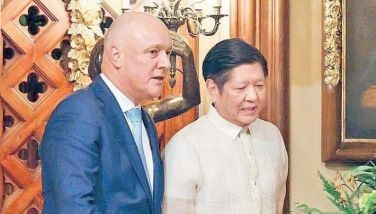Ruined churches may be used for tourism
MANILA, Philippines - Even in ruins, the centuries-old churches of Bohol could still become tourist attractions.
Fr. Milan Ted Torralba, executive secretary of the Catholic Bishops’ Conference of the Philippines-Committee for the Cultural Heritage of the Church, said that even if the seven churches, named as national cultural treasures, have crumbled or been severely damaged, they could still become tourist spots.
The six churches in Bohol classified as national cultural treasures that were damaged by the massive earthquake last Oct. 15 are the San Pedro Apostol Church in Loboc, Our Lady of the Immaculate Conception Church in Baclayon, the Church of Our Lady of Light in Loon, the Diocesan Shrine of Saint Vincent Ferrer-Holy Cross Parish in Maribojoc, the Church of Our Lady of the Assumption in Dauis, and the Church of Santisima Trinidad in Loay.
While it would take several years for these churches to be rebuilt, Torralba said they could still utilize these houses of worship as part of the province’s tourist attractions.
“As of now, what we have are ruins. When you go abroad and see temples, that is the same case – they already are ruins. In a way, it is like an archeological site,†he said.
Torralba, chairman of the Diocese of Tagbilaran Commission for the Cultural Heritage of the Church, said they could put up signs pointing to the direction of the ruined churches.
He said the signs were put up to cordon off unsafe areas and keep them off limits to the public.
The restoration works on the churches “could still be a tourism related activity†just like in other countries wherein ruins have become prime attractions, such as the Aztecs in Mexico and Machu Picchu in Peru.
Torralba said they would be giving tourists the opportunity to contribute to the reconstruction of the churches.
It is possible that they would pay an entrance fee to gain access to the area where the restoration works are going on, he said.
Torralba said they might have to raise up to P100 million to fund the restoration of the damaged churches.
They have also encouraged the affected churches to open their own bank accounts so they would directly receive the donations.
Torralba, who hails from Bohol, said their centuries old churches may not be the oldest in the country.
“But the important thing is that the churches of Bohol, they are the best preserved, meaning their authenticity and integrity were 90 to 100 percent. Before the earthquake, this is what they looked like 200 to 300 years ago, now everything is gone,†he said.
Torralba said that it would take years, depending on the extent of the damage, to rebuild the damaged churches.
He said the Church in Loon took 30 years to build but it only took 30 seconds to be destroyed by the quake.
Torralba said they are looking forward to using new technology in reconstruction that would only take them six years to complete the restoration.
“We intend to build a firmer (foundation), build them more sturdy... We would make use of retrofitting so that we will be able to have churches that are, in a way, permanent. I do not think we can build structures that are earthquake proof, may be earthquake resistant,†he said.
Torralba said that even before last week’s earthquake, they were already in the process of retrofitting the churches but they were not able to complete this when the tremor struck.
He said it took them a while to work on the restoration because they lacked the much-needed resources and time to shore up the churches.
Torralba said the materials from the ruins would be used in rebuilding the churches.
It would be the National Museum that would review the plans for the restoration of the churches.
He said the National Museum has already identified 42 national cultural treasure churches all over the country, but said he could not remember if any one of the churches had been retrofitted.
Release the funds
Sen. Juan Edgardo Angara, on the other hand, called for the immediate release of funds for the rehabilitation and preservation of heritage sites damaged by the strong quake in Bohol.
Angara, the principal author of Republic Act 10066 or the National Cultural Heritage Act, lamented reports that the National Commission on Culture and the Arts (NCCA) has not received the seed money for the national endowment fund for conservation.
The money is supposed to fund the restoration of damaged heritage structures.
Under RA 10066, the NCCA is entitled to a National Endowment for Culture and the Arts amounting to P500 million to be contributed by the Philippine Amusement and Gaming Corp. and/or General Appropriations at the minimum rate of P100 million per year for five years, Angara said.
“The Heritage Law was passed to lay the overall framework for government to identify, protect and promote the country’s many national treasures. We should see to it that the law’s significant provisions, including the release of funds, are properly implemented,†Angara said.
Senate President Franklin Drilon said earlier the government could finance reconstruction or repairs of the destroyed churches.
Drilon said the government can do so on historical and cultural sites as proclaimed and declared by the United Nations and the NCCA.
“In my opinion, we can use state funds for historical sites. The government cannot finance local churches or places of worship with no historical value,†Drilon said. – Christina Mendez
- Latest
- Trending



























